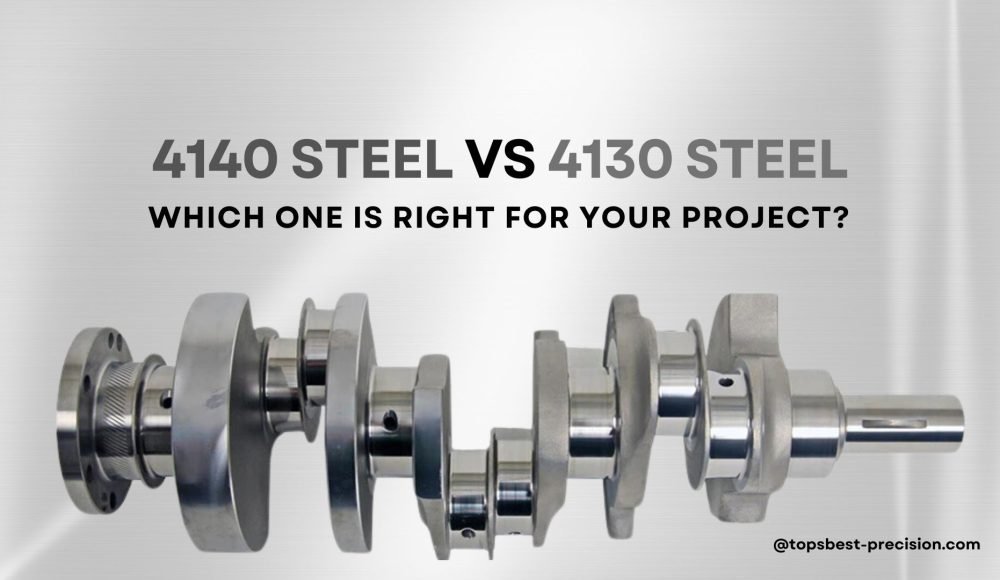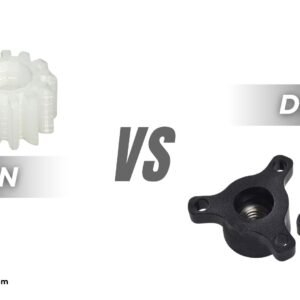La selección de una aleación de acero adecuada suele presentar numerosos desafíos. Porque la elección del material incorrecto puede comprometer la integridad estructural y la calidad general.. Por suerte, siempre hay una manera de tomar una decisión más fácil si sabes distinguir los aspectos de los materiales.. Echemos un vistazo a las propiedades mecánicas y aplicaciones de 4140 vs 4130 aleaciones de acero con la intención de comprender, Por qué estos aceros son muy apreciados en la fabricación de piezas o productos sofisticados.. Esta comprensión le ayudará a tomar decisiones en su negocio..
Comprensión de los grados de acero en la creación rápida de prototipos
Seleccionar el grado de acero adecuado es fundamental para el éxito de un proyecto de creación rápida de prototipos.. Los profesionales de la ingeniería a menudo encuentran dificultades a la hora de elegir el material adecuado, lo que puede provocar contratiempos o fallos..
El grado de acero 4130 Es un acero al cromo-molibdeno con un contenido de carbono de entre 0.28% y 0.33%. Proporciona buena soldabilidad y conformabilidad y, por lo tanto, es óptimo para prototipos de formas complejas en las industrias automotriz y aeroespacial.. Además, Tiene buena maquinabilidad y su respuesta al tratamiento térmico lo hace adecuado para su uso en la creación rápida de prototipos..
En comparación, 4140 acero contiene un carbono entre 0.38% a 0.43%. El alto contenido de carbono lo hace más resistente y duro en comparación con otros tipos de acero.. 4140 Es fundamental para aplicaciones de alta tensión, por ejemplo para dar forma a engranajes y ejes.. La resistencia al desgaste adquirida mediante el tratamiento térmico es aún mejor., contribuyendo a la eficacia de la unidad en aplicaciones de alta tensión.
4140 Acero aleado de un vistazo?
4140 El acero aleado es una aleación típica de cromo-molibdeno.. Presenta múltiples propiedades mecánicas., beneficiando a varios sectores. aleación de acero 4140 Se emplea con mayor frecuencia cuando la alta resistencia y tenacidad son preocupaciones importantes.. Se usa ampliamente donde se producen piezas que deben estar sujetas a cargas pesadas, como engranajes., ejes, y ejes.
Composición de la aleación 4140:
4140 El acero normalmente contiene:
- Carbón (C): 0.38% – 0.43%
- Cromo (cr): 0.8% – 1.1%
- Molibdeno (Mes): 0.15% – 0.25%
La presencia de estos componentes suele ayudar a mejorar la dureza general y la resistencia durante la exposición al desgaste abrasivo..
Propiedades
Fortaleza:
- Alta resistencia a la tracción o hasta 100000 psi.
- Esta característica garantiza que tenga un alto límite elástico, por lo que es ideal para transportar cargas pesadas..
Dureza:
- Obtiene una alta dureza mediante procesos de tratamiento térmico como el temple y el revenido..
- El material permanecerá duro incluso en aplicaciones donde esté sujeto a cargas elevadas..
Ductilidad:
- Una buena ductilidad significa que el moldeado no provocará que el material se rompa..
- Utilizado en aplicaciones de mecanizado y conformado..
Soldabilidad:
- Se puede soldar pero se debe tener cuidado para evitar grietas., de lo contrario, es posible que sea necesario precalentar.
Tenacidad:
- Tiene alta resistencia al impacto, que es adecuado para aplicaciones con mucho movimiento.
Aplicaciones
4140 El acero aleado se utiliza en diversas aplicaciones., incluido:
- Automotor: Bloques de motor, bielas, pistones, árboles de levas, válvulas y resortes, engranajes de transmision, diferenciales, ejes de transmisión, axel, ruedas, y suspensiones.
- Aeroespacial: Tren de aterrizaje; piezas del motor; y piezas estructurales.
- Fabricación: ellos incluyen; Máquinas herramienta, Muere, y plantillas.
- Petróleo y gas: Las barras de perforación y los recipientes a presión son las dos partes principales del engranaje..
Tratamiento térmico
4140 El acero puede adaptarse a múltiples procesos de tratamiento térmico, incluidos:
- Recocido: El recocido produce una mayor capacidad de mecanizado, así como una reducción de la dureza..
- Temple: Esto lo hace aún más resistente y fuerte después del calentamiento..
- Templado: Ayuda a disminuir la fragilidad y al mismo tiempo aumenta la resistencia en consecuencia..
4130 El acero de un vistazo?
4130 El acero es un acero de cromo-molibdeno de baja aleación.. Estas aleaciones se utilizan a menudo en el sector aeroespacial., automotor, y las industrias de la construcción. aleación de acero 4130 es apreciado por su gran soldabilidad, ductilidad, y fuerza. Se puede utilizar tanto para fines estructurales como mecánicos debido a su flexibilidad..
composición de 4130 Acero:
4130 El acero normalmente se compone de:
- Contenido de carbono: 0.28% – 0.33%
- (cr) contenido: 0.8% – 1.1%
- Molibdeno (Mes): 0.15% – 0.25%
Propiedades
Fortaleza:
- Tiene una excelente combinación de resistencia y dureza..
- La resistencia a la tracción puede llegar hasta aprox.. 90,000 psi.
Ductilidad:
- Demuestra buena ductilidad, lo que permite doblarlo., arrollado, etc..
- Promueve actividades como formar y cortar..
Soldabilidad:
- Muy fácil de soldar y por lo tanto se puede fabricar..
- Las secciones más gruesas pueden requerir precalentamiento para evitar la formación de grietas durante el proceso de enfriamiento..
maquinabilidad:
- El material exhibe buena maquinabilidad cuando está recocido..
Tratamiento térmico:
- Puede tratarse térmicamente para mejorar la resistencia y la dureza..
- Algunos de los tratamientos más conocidos comprenden el recocido., temple, y templado.
Aplicaciones
4130 El acero se utiliza en una variedad de aplicaciones., incluido:
- Automotor: Carrocerías, miembros estructurales, y componentes de suspensión.
- Aeroespacial: Piezas estructurales aeroespaciales y conjuntos de estructuras de aviones..
- Petróleo y gas: Como; tubos de perforación, y recipientes a presión.
- Ingeniería General: Plantillas, accesorios, y herramientas.
Tratamiento térmico
Similarmente, 4130 El acero es compatible con varios métodos de tratamiento térmico dados por:
- Recocido: Suaviza y mejora la capacidad de procesar metal con una máquina herramienta..
- Temple: Mejora la resistencia y la rigidez cuando se sumerge en agua fría para que se enfríe muy rápido..
- Templado: Equilibra fuerza y dureza minimizando la posibilidad de volverlo quebradizo..
4130 contra 4140 Acero: Análisis comparativo
La siguiente tabla destaca las diferencias y propiedades clave de cada grado de acero., Garantizar claridad y precisión técnica..
| Propiedad | 4130 acero | 4140 acero |
| Composición | Azufre: 0.040% (máximo) | Azufre: 0.040% (máximo) |
| Silicio: 0.15%-0.35% | Silicio: 0.15%-0.35% | |
| Molibdeno: 0.15%-0.25% | Molibdeno: 0.15%-0.25% | |
| Tratamiento térmico | Normalizado y templado | Templado y revenido |
| Calentado a 1600°F-1700°F para normalizar | Calentado a 1600°F-1650°F para endurecer | |
| Enfriado al aire | Apagado en aceite o agua. | |
| Propiedades mecánicas | Resistencia a la tracción: 560-725 MPa | Resistencia a la tracción: 655-979 MPa |
| Fuerza de producción: ~460MPa | Fuerza de producción: ~415MPa | |
| Dureza: 15-23 CDH | Dureza: 28-32 CDH (curtido) | |
| maquinabilidad | Más fácil de mecanizar gracias a su menor contenido de carbono | Requiere un mecanizado cuidadoso para evitar grietas. |
| Soldabilidad | Soldabilidad superior | Requiere tratamiento de precalentamiento y post-soldadura |
| Adecuado para métodos de soldadura estándar | Puede requerir técnicas especializadas. | |
| Formas materiales | Comúnmente disponible en tubo y lámina. | Disponible en forma de barra y placa. |
| Aplicaciones | Utilizado para engranajes, brocas, y repuestos automotrices | Ideal para componentes de alta tensión como cigüeñales y ruedas dentadas |
4130 vs. 4140 Acero: Consideraciones para seleccionar el grado correcto
La resistencia y la tenacidad son relativamente impresionantes para ambos materiales de acero.. Aunque no son idénticos. Conocer sus diferencias es importante para tomar la decisión correcta al elegir el acero adecuado para sus necesidades de construcción..
Compare la composición química de ambos aceros
El 4140 El acero ha aumentado hasta 0.40% carbono y correspondiente 0.90% cromo en comparación con el acero al carbono simple. Mientras 4130 El acero contiene menos carbono.. Las partes interesadas deben considerar componentes clave como el carbono., manganeso, silicio, azufre, y molibdeno de ambas aleaciones para buscar el equilibrio óptimo.
Comprensión de las propiedades mecánicas
Cuando un proyecto exige alta dureza, 4140 es la opción preferida para aplicaciones exigentes. Además, Tiene un alto contenido de carbono y manganeso con buena resistencia a las prácticas de tratamiento térmico, incluido el temple y el revenido.. 4130 acero, Ofrece un límite elástico y límite elástico adecuado y presenta buena formabilidad.. Ambos aceros deberán tener sus características mecánicas analizadas y comparadas., para que pueda decidir cuál se adapta a los requisitos de su proyecto.
Comprenda su necesidad de maquinabilidad
Ventajas como la fácil maquinabilidad hacen 4130 acero adecuado para aplicaciones que requieren alta maquinabilidad. La alta resistencia al corte lo hace más deseable debido a la facilidad de mecanizado.. Como resultado, A menudo conduce a un proceso fluido al reducir las virutas y desgastar la fuerza de corte durante la fabricación.. Sin embargo, si la fuerza es un requisito indispensable, entonces opta por 4140. A pesar de, puede presentar desafíos de eliminación lenta de virutas, y altas fuerzas de corte. Entonces, Siempre es necesario evaluar sus necesidades de mecanizado para identificar el acero adecuado para su proceso de producción..
Evaluar los requisitos del tratamiento térmico
- En primer lugar, Debes averiguar qué tratamiento térmico específico es necesario para tu caso..
- Si tu proyecto necesita un endurecimiento específico, entonces es muy útil que 4140 puede ser templado.
- Observe el comportamiento de ambos aceros en diferentes procesos de tratamiento térmico..
- Esta evaluación le ayudará a elegir el material que se ajuste a sus necesidades..
Evaluar el costo
El costo de 4130 vs 4140 El acero generalmente depende del precio y la cantidad del proveedor.. Generalmente, 4140 El acero es más costoso que otros grados similares.. Esto es así porque el material tiene mayor resistencia y dureza., Propiedades que son importantes para un uso exigente.. También son habituales las fluctuaciones de precios entre los proveedores.. Siempre hay que tomarse un tiempo para evaluar los requisitos del proyecto.. Esto le ayudará a determinar el acero adecuado que sea más barato de comprar y, al mismo tiempo, mantenga una alta calidad..
Tops Precision ofrece lo mejor 4140 y 4130 Servicios de torneado de acero
El mecanizado de acero a menudo presenta ciertos desafíos. Se emplean diferentes grados de acero dependiendo de los requisitos específicos., pero la selección del grado podría resultar desalentadora principalmente si se consideran las características de cada grado.
En Tapas de precisión, Nuestro personal profesional toma el control total de todos sus servicios de mecanizado de acero.. También ofrecemos revestimientos de superficie de alta calidad para que sus piezas de acero luzcan como nuevas.. Póngase en contacto con nuestro centro de soporte ahora para obtener su cotización gratuita y permítanos convertir su visión en realidad..
Conclusión
Aceros de baja aleación 4140 y 4130 Los grados son reconocidos por su alta resistencia y ductilidad satisfactoria.. Debido a sus excelentes propiedades anticorrosivas., Estos materiales encuentran uso en una variedad de industrias manufactureras.. Sin embargo, Las diferencias son evidentes entre los dos grados.. Por lo tanto, Uno debe comprender todas estas diferencias en un intento de elegir el acero adecuado para un proyecto previsto..



